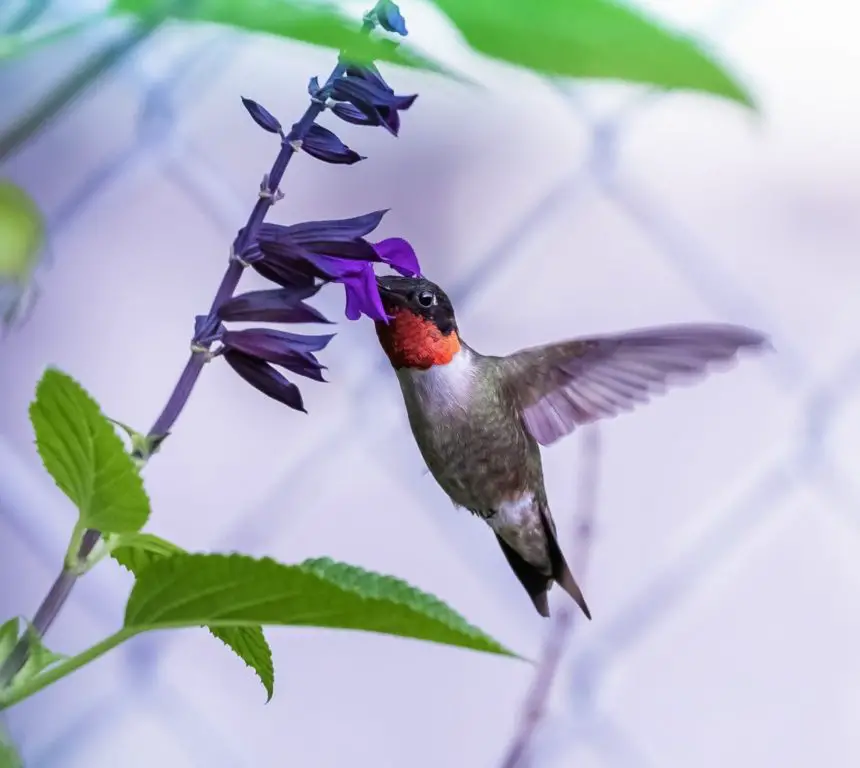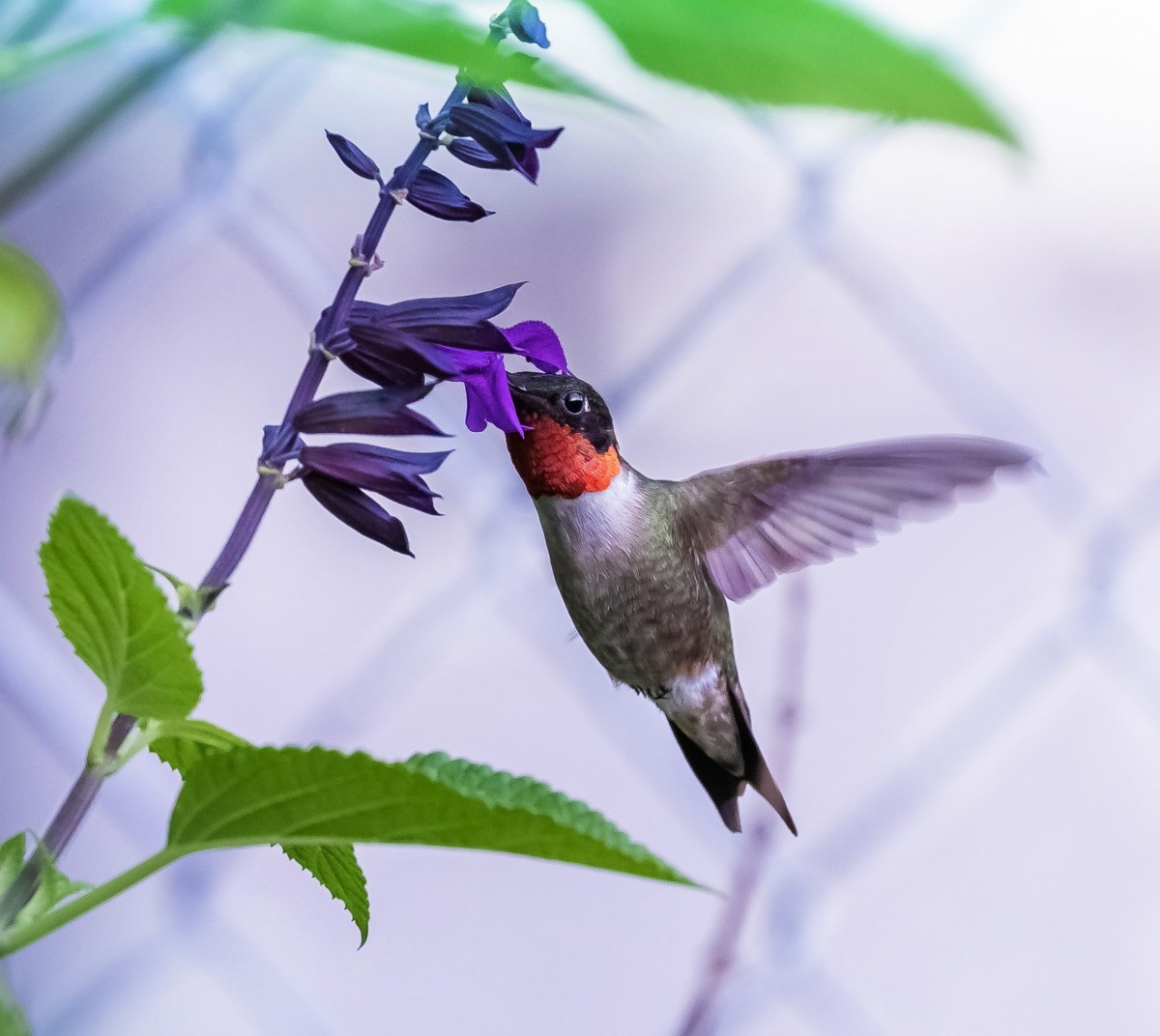This post contains affiliate links.
When do hummingbirds arrive in Georgia?
Migrating hummingbirds begin arriving in Georgia as early as February into the first week of March from their southern wintering homes in Mexico and Central America. Some Ruby-throated hummingbirds live in Georgia year-round and do not migrate.
Hummingbirds migrating through Georgia, including some Ruby-throated hummingbirds, continue their journey North into the eastern half of the United States all the way into Canada.
Many migrating hummingbirds start their spring migration from as far south as Panama, about 3,500 miles away from Georgia. Some migrating hummingbirds to Georgia choose to fly across the Gulf of Mexico non-stop, a distance of 500 miles.
Other migrating hummingbirds start their spring migration from as close as Mexico, about 1,200 miles from Georgia.
All migrating hummingbirds, regardless of their starting point, arrive in Georgia in February or the first week of March.
The further away from Georgia the hummingbird begins the journey the earlier the hummingbird will need to start the migration trip.
According to the Georgia Department of Natural Resources, Ruby-throated hummingbirds are the only species of hummingbirds that nest in Georgia east of the Mississippi River. They breed throughout the eastern United States as far west as eastern Texas, Oklahoma and up north to Minnesota.
Most hummingbirds seen in Georgia during spring migration are not nesting in Georgia with the exception of the Ruby-throated hummingbird. Ruby-throated hummingbirds prepare for their nesting season in April.
The reason for northern hummingbird migration is to reach their nesting areas of choice. Once they reach their preferred nesting destination the focus changes from migration to finding a mate and raising a family.
Upon reaching their breeding grounds in early spring, Georgian observers will see male Ruby-throated hummingbirds perform dive displays and dance maneuvers to attract a flirty female.
Each species of hummingbirds have their own unique mating dance ritual or courtship routine to attract a female.
See my article: Hummingbird Dance: 5 Interpretive Explanations
There is no penetration during the mating ritual as male hummingbirds do not have any external sexual organs.
The mating process only lasts for approximately 3-5 seconds while the cloacae (kloh-ay-see) of both hummingbirds are pressed together which is called a “Cloacal Kiss” (kloh-a-coal kiss).
A female hummingbird’s nest will take five to seven days to build. They prefer to build their nest in deciduous trees 10-20 feet high.
The nest is constructed of plant materials for the base of the nest such as grasses, animal fur, cotton fiber, young immature leaves and small sticks or twigs to create a strong shelter that is resilient against outdoor elements. All of these resilient outdoor elements are held together with spider web silk, which acts like glue.
See my article: Hummingbird Parents: (Mating to Nesting)
See my article: Baby Hummingbirds: (Egg to Fledgling)
Female Ruby-throated hummingbirds raise 2 families called “broods” per year. The first family is in April through May and the second family is in June through August.
The Ruby-throated hummingbird is the only hummingbird that nests in Georgia. On average they raise two families per year. However, there are occasions where they are able to work in an additional family for a total of three families per year.
When should I put out hummingbird feeders in Georgia?
Hummingbird enthusiasts in Georgia should put out their hummingbird feeders in early February for migrating hummingbirds that begin arriving in Georgia during the month of February and the first week of March.
Some Georgia hummingbird admirers leave hummingbird feeders up all winter long to provide life-saving nectar to Georgia’s only year-round resident, the Ruby-throated hummingbird. This selfless act also provides nectar to other migrating species unable to migrate because of injury or old age.
See my article: 11 DIY Ways to Keep Hummingbird Nectar From Freezing
How long do hummingbirds stay in Georgia?
Some Ruby-throated hummingbirds stay in Georgia year-round. The first migrating hummingbirds arrive in Georgia in February and the last migrating hummingbirds that leave Georgia are usually gone by mid-October.
The year-round Ruby-throated hummingbirds or other migrating hummingbirds that are too injured or old to migrate are the primary hummingbirds people from Georgia will see in the winter, although Georgia’s micro climate allows a very limited number of all Georgia hummingbirds to over-winter in Georgia.
Hummingbirds have exceptional memories and they will remember feeders they have visited on their way north to their mating destinations.
See my article: Hummingbird Adaptation and Remarkable Ability to Locate Food
As summer sets in, the number of hummingbirds that visit feeders in Georgia will decrease.
Year-round native Ruby-throated hummingbirds in Georgia brave through the heat and humidity and will be the vast majority of hummingbirds seen in Georgia’s summer months.
See my article: How to Help Hummingbirds in Hot Weather
When the obstacles of summer heat are difficult to manage and unbearable, finding ways to keep your hummingbirds happy and hydrated with cool nectar is crucial.
See my article: How to Cool Hummingbird Nectar in Hot Weather
As hummingbirds begin their migration south again expect hummingbird feeders to become busy and popular. Hummingbirds remember the exact location of hummingbird feeders they have visited along their earlier northern migration path.
When do hummingbirds leave Georgia?
Hummingbirds that choose to migrate from Georgia to Mexico and Central America start migration in August or early September and most migrators are gone by late October. Any hummingbird seen in Georgia during the winter is most likely a Rufous, a Calliope or a Ruby-throated hummingbird.
Some Ruby-throated hummingbirds choose to over-winter in Georgia as do some Rufous and Calliope hummingbirds.
Hummingbird migration is triggered by circadian or daily internal clock and the circannual rhythm or yearly clock. Changes in the weather, temperature, time of season, decline in food supply and shorter days with less sunlight are factors that influence the beginning of fall migration.
The male Ruby-throated hummingbirds are the first to depart and head south, leaving by the end of July. The female Ruby-throated hummingbirds will follow suit, after they have completed their nesting season.
After the fall migration of Georgia hummingbirds, beginning in August to early September and ending in October, most hummingbirds will have migrated south, overwintering in Mexico and Central America.
This elongated migration time frame ensures late straggling migrates have enough food to fuel their bodies before making the long taxing migration south for the winter.
How long does it take a Georgia hummingbird to migrate?
It takes a Georgia hummingbird about 50 hours of flying at its average migrating flight speed of 30 mph to fly from Georgia to the Mexican border 1,500 miles away. Some fly at a relaxed distance as slow as 1 hour a day, others can fly 500 miles non-stop in about 20 hours, as some do while migrating across the Gulf of Mexico.
Hummingbirds do not migrate all at the same time to ensure all resources are not consumed and depleted. They do not migrate in flocks as do other birds; they migrate individually on their own personal time clock.
As migration approaches, hummingbirds routinely gain 25% to 50% of their body weight by consuming nectar from feeders, flowering plants, and catching bugs in mid air for protein. The extra body weight and fat fuel the hummingbird for their long migration journey.
Expect to have an increased volume of hummingbird visitors to your feeder during this migration time beginning in August and ending in October, therefore, maintaining feeders is critical in order to maximize food consumption that nourishes and prepares their bodies for migration.
See my article: Should I Keep My Hummingbird Feeder Out During the Winter?
When should I take down hummingbird feeders in Georgia?
The best time to take down hummingbird feeders for the winter in Georgia is in mid-November or when there have been no consistent hummingbirds at the feeders for a couple of weeks. Feeders can be up all winter to feed the wintering Ruby-throated, Rufous and Calliope hummingbirds or those unable to migrate, but removal in mid-winter could be fatal.
This rule only applies to those who choose to take down their feeders every year, however many choose to leave their feeders up year-round providing consistent nourishment for the Year-round Native Ruby-throated as well as Rufous hummingbirds, which is considered the most common wintering hummingbird. All other hummingbirds that are too old or injured to migrate depend on consistent nourishment.
The Rufous and Calliope hummingbirds are both winter residents to Georgia.
According to the Georgia Department of Natural Resources, Rufous hummingbirds are the most commonly seen wintering hummingbird in Georgia. Therefore, it is highly recommended to keep at least one feeder available during the winter to accommodate these hummingbirds.
Providing and maintaining a steady food supply during the winter is critical for hummingbirds who become dependent on the feeder for winter nutrition. Taking them down could be life threatening!
The dilemma every hummingbird enthusiast struggles with every year is leaving the feeders up all year or choosing to take them down.
See my article: Should I Keep My Hummingbird Feeder Out During the Winter?
See my article: 11 DIY Ways to Keep Hummingbird Nectar From Freezing
Where do Georgia hummingbirds go in the winter?
Georgia migrating hummingbirds travel south to winter in Mexico, Guatemala, Belize, Honduras, El Salvador, Nicaragua, Costa Rica and Panama.
All hummingbirds have excellent memories and can remember every flower or feeder they have visited during migration and will return to those sites along their migration pathway year after year.
Some hummingbirds have been spotted returning to a feeder for a couple of years after the feeder was removed.
See my article: Hummingbird Adaptation and Remarkable Ability to Locate Food
Happy Hummingbird Watching!

joevianiphoto
Backyard Visitors participates in affiliate programs which compensate us for referring traffic.

